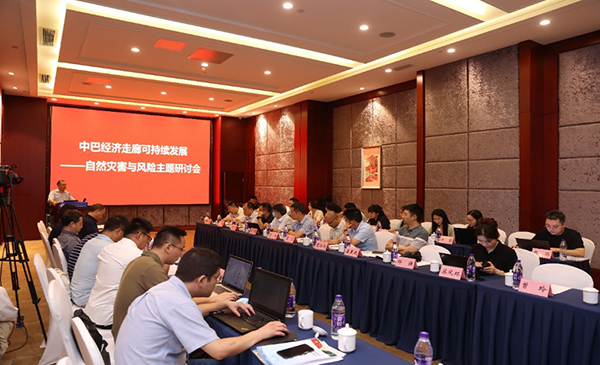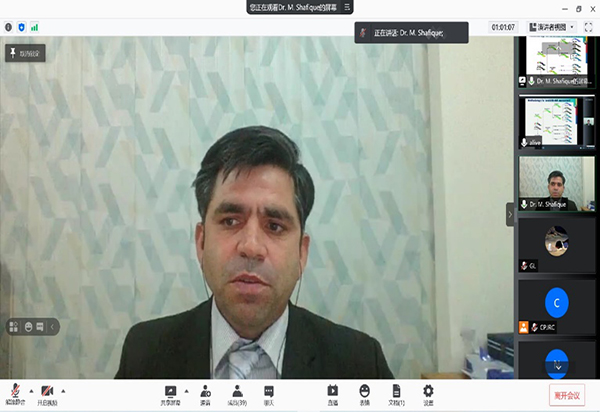
China-Pakistan High-level Webinar on Earth Sciences Cooperation: Thematic Webinar on Natural Disaster and Risks Management
Publisher: CPJRC
time: 2021-07-23
On July 22, the "China-Pakistan High-level Webinar on Earth Sciences Cooperation: Thematic Webinar on Natural Disaster and Risks Management" was held by the China-Pakistan Joint Research Center on Earth Sciences (CPJRC) successfully in Chengdu.
This meeting was held by the third research field of CPJRC, and is held both online and offline. Prof. Gao Liang, Secondary Inspector of the Science & Technology Department of Sichuan Province, Prof. Chen Gang, Deputy Director of Chengdu Science and Technology Bureau, and Prof. Cui Peng, Academician of Chinese Academy of Sciences (CAS), Director of CPJRC and Researcher of the Institute of Mountain Hazards and Environment, CAS, attended the opening ceremony and delivered speeches. The opening ceremony of the meeting was chaired by Prof. Su Lijun, Deputy Director of the Institute of Mountain Hazards and Environment, CAS and Executive Deputy Director of CPJRC.
Prof. Gao Liang spoke highly of CPJRC's achievements in international scientific and technological cooperation and international talent training and exchanges. He said that the Science & Technology Department of Sichuan Province would continue to support the construction of CPJRC. He also hoped that through this webinar, relevant personnel could promote the construction of CPJRC, combine the advantages of Sichuan Province with the needs of Pakistan, and output more technologies and achievements, so that Sichuan could make contributions to the promotion of the Belt and Road Initiative.
Prof. Chen Gang fully affirmed the significance of CPJRC and its achievements since establishment based on the importance of the China-Pakistan Economic Corridor. He pointed out that Chengdu, as an important node of the Belt and Road and an international hub, would continue to contribute to the construction and development of CPJRC. He also hoped that CPJRC would follow the guidance from the top level, and break through basic scientific issues and core technologies, so as to further enhance bilateral cooperation and planning.
Prof. Cui Peng introduced the background, purpose and significance of CPJRC, major milestones in the preparation process and challenges. Currently, CPJRC is committed to cutting-edge scientific research in the world as well as solving the four major problems of resources, environment, ecology and disasters arising during the sustainable social and economic development under the background of the China-Pakistan Economic Corridor. He clearly pointed out the purpose of the seminar, which is to focus on the special scientific issues of the research area and the specific next-step plan according to the unique endowment of CPEC, to discuss with Pakistan the mode of cooperation in the post-pandemic era, to strengthen the contribution of the Center to external cooperation of Sichuan Province and Chengdu City, and to build CPJRC into a state-level science and technology platform in earth sciences in the future.
The meeting was held in both the morning and afternoon. In the morning, focusing on the future plans and expected results of researches in the field of natural disasters, Prof. Li Li, Researcher of the Institute of Geophysics of China Earthquake Administration, Prof. Su Lijun, Researcher of the Institute of Mountain Hazards and Environment, Chinese Academy of Sciences (CAS), Prof. Lin Zhaohui, Researcher of the Institute of Atmospheric Physics, CAS, Prof. Xu Min, Researcher of the South China Sea Institute of Oceanology, CAS, Prof. Liu Yu, Researcher of the Institute of Earth Environment, CAS, and Prof. Qi Shengwen, Researcher of the Institute of Geology and Geophysics, CAS, made reports from the aspects of earthquake, mountain hazards, meteorological disasters, marine disasters, ancient environment disasters, and major engineering disasters respectively. They summarized the preliminary research work for the China-Pakistan Economic Corridor and scientific research achievements, clarified and refined the research plans for the next two years, the scientific research cooperation with Pakistan and the expected output. Then the experts participating in the meeting carried out exchanges and discussions over the #sql_sel#ion of international students, talent training, the form of scientific research cooperation with Pakistani scientists, as well as methods to improve CPJRC's influence and publicity.
In the afternoon, 6 scientists from China and Pakistan made academic reports on natural disasters such as floods, earthquakes, tsunamis and extreme weather as well as risk researches. They are: Prof. Liu Weiming, Researcher of Institute of Mountain Hazards and Environment, CAS; Professor Naveed Ahsan of the University of the Punjab, Pakistan; Researcher Qiu Qiang of the South China Sea Institute of Oceanology, CAS; Associate Professor Muhammad Shafique of National Centre of Excellence in Geology, University of Peshawar, Pakistan; Researcher Lin Zhaohui of the Institute of Atmospheric Physics, CAS; and Assistant Professor M. Jahangir Khan of Bahria University of Pakistan (Karachi Campus).
Through this meeting, CPJRC's partners and scientists from China and Pakistan can have a better understanding of each other, which will help realize the intercrossing and integration of disciplines during research, produce better scientific research results, and establish the cooperation mechanism among the Center, the scientific research units and persons, so as to truly realize the purpose of joint contribution, shared benefits and win-win.
30 experts and scholars from 9 units attended the meeting offline, including the Institute of Geophysics of China Earthquake Administration, the Institute of Atmospheric Physics of CAS, the Institute of Earth Environment of CAS, the Institute of Geology and Geophysics of CAS, the South China Sea Institute of Oceanology of CAS and the University of Peshawar, Pakistan. In addition, more than 60 people attended the meeting through video conference or live video.

Leaders delivered a speech

The offline meeting

The online meeting

Photo of the meeting